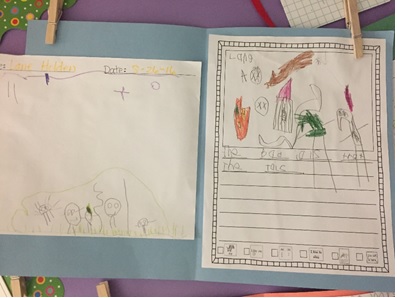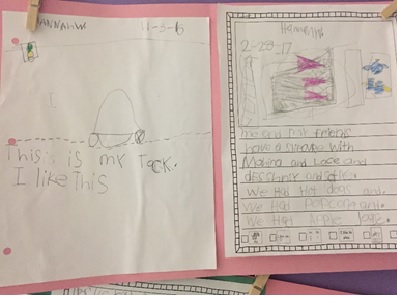That Thing You Do! segment posted on Thursdays throughout this year took a short hiatus while I wrapped up end-of-school tasks. I’m so pleased today to showcase a teacher on our campus who worked tirelessly this year setting new goals for herself and her young writers. Andi Spaulding is a kindergarten teacher on the PreK-6 campus where I work as an instructional coach. As I read Andi’s blog post, I thought of Ralph Fletcher‘s exhortation in his book, Joy Write. “I think that teachers might consider creating greenbelts. A writing greenbelt, a place where that wild writing could still exist and flourish, and I think that we’ll find that a lot of times the kids that are not flourishing in the more constricted world of writing workshop can find their stride as writers in a writing greenbelt.” Andi has certainly created a beautiful greenbelt in her kindergarten classroom this year. It’s an honor for me to share Andi’s post with readers today. You can follow Andi on Twitter @andi_spaulding.
As a kindergarten teacher, or any teacher for that matter, it is hard to be satisfied with the way you teach year to year. I am in my eighth year as a teacher, but only my third year in the same grade at the same school.
Writing has always been a challenge for me. I see what other teachers do and have tried different things based on my students’ needs, but this is the first year I feel I have had real success. In years past, I have had a hard time with students being able to just get something on their paper. My school curriculum specialist, Valinda Kimmel, has seen other teachers have success with what she shared with me. As you will see and hear, this was amazing!
She mentioned to me, just let the kids write. Take a paper, fold it in half. Tell the students to draw their picture on the top and do their writing on the bottom. One of the big reasons this very simple model helps is because the students draw and write at their developmental level. They are not expected to be fantastic writers right off the bat.
This year has worked so well for me and my students, because they have learned to get started quickly and put something on their paper. Even those that struggled with ideas at the beginning have seen examples from me and their peers and either share or spin it in their own direction. We have worked with writing goals and they understand what they need to become a better writer.
Now the burning question; has everything been smooth using this model of letting them write freely? I do have students that want to show me their writing every day. I also have students that want to come and ask me how to spell things constantly. It is very hard to turn them away, especially when they give me their sad face because they can’t share. I just have to sound like a broken record and remind them they are working independently. I have had to really enforce them writing on their own until it is their day to conference.
They also need to know they are never “done” and to be able to get a new piece of paper as needed. This way they should never stop working until the timer goes off. This also contributes to teaching them how to work independently.
At the beginning of the year, we discussed ideas for writing. I also model stories from my own life to show them where ideas can come from. When conferencing, I have examples of my writing and other student writing, so they have real life examples. When I see that students are running out of ideas, we do a new anchor chart for the students to refer to.

The student above went from not knowing how to write his name to creating his own sentence. I only helped him by drawing the lines for him. He came up with his own ideas. He saw the Troll’s movie and decided to write about that. His sentence says, “The bad guys trapped the trolls.” Back in August, he did not know how to even write letters as you can see in his first example. In his second example, he is connecting sounds to letters and words to thoughts.

This student came later in the year. She was already a reader and a writer. She mostly needed to finish a writing piece and add more details. As you can see, in just a few short months, she went from writing just a couple of sentences, to writing more of a story and giving more details.
In January, we transitioned to lined paper to help them move into a more formal style of writing. In years past, I have had various formats of lined papers. This year, I feel that using the plain sheet of paper has been less stressful for the students. I just encouraged them to draw and write. If they couldn’t write yet, I told them to practice writing their letters, any letters. Once they knew their sounds, they were able to match beginning sounds. Now most of them can get multiple sounds for each word as well as writing sights words that are spelled correctly.
The most exciting thing about our writing this year? When I ask my students, “How long should we write today, ten or fifteen minutes?” They yell,”FIFTEEN!”
–Andi Spaulding










